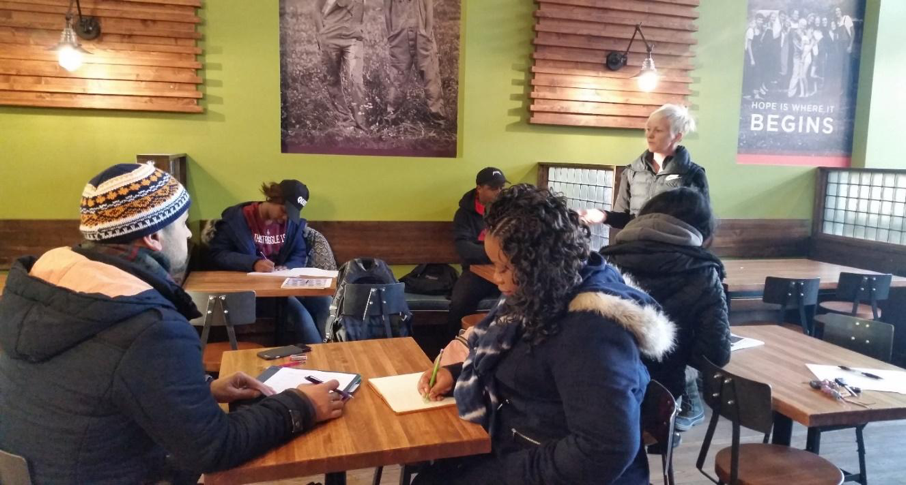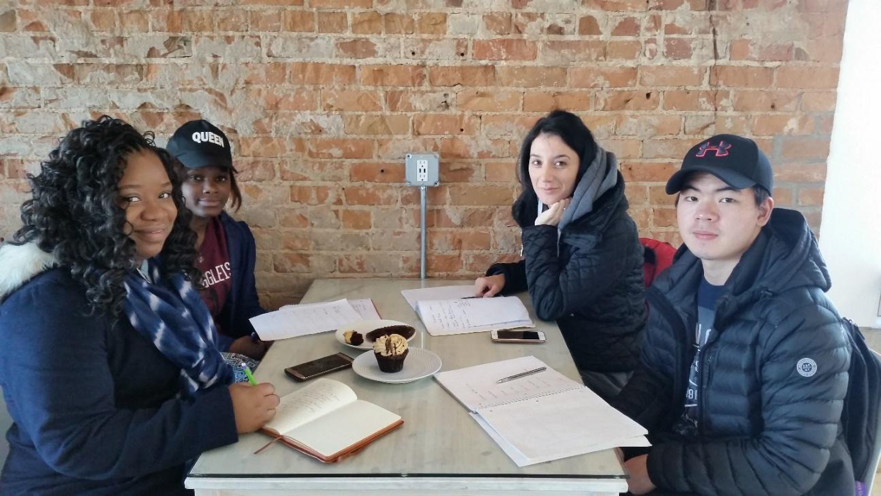This article makes the case for incorporating off-campus learning experiences into international students’ second language instruction at the college level.
Key words: international students, college, community, authentic language
Walmart. Sometimes the mall, but mostly Walmart. That is where I most often run into the international students who enroll in my college writing classes. One time, I picked up two grocery-laden students at the Walmart bus stop and gave them a lift to their apartment. Another time, I chatted with a student working at Walmart as he manned the self-checkout aisles. Once I even ran into a student at 5:00 a.m. while I was picking up a pre-dawn box of doughnuts.
I recognize the appeal of Walmart for international students. The store is easy to access by public transportation, stays open 24 hours a day, and offers the lowest prices in town. Yet, I worry about these Walmart trips. Specifically, I am concerned that they may constitute students’ singular contact with my admittedly small but nonetheless interesting college town.
For a variety of reasons, international students may not venture far into the community. Many spend the majority of their time on or near the college campus. This is a loss for both the community and the students. Communities miss out on the diversity that the university’s international population can provide; conversely, students are unable to secure rich opportunities for learning that are practically at their doorsteps. Language teachers can help remedy this situation. Recognizing the benefits of off-campus interactions for our students, we can design learning experiences that engage students with the community, exploring new ways to promote students’ language development.
In this article, I make a case for incorporating off-campus activities into second language instruction at the college level. I begin by describing the benefits of facilitating off-campus learning experiences for international students. I then detail one off-campus excursion that I led, funded by a MinneTESOL mini-grant. I conclude by highlighting some areas to consider when designing an off-campus experience for students. My aim is to encourage other English language teachers to consider how they might utilize their community to support student learning.
Benefits of (Ad)venturing into the Community
Getting outside the classroom and into the community takes some work. Thus, teachers need to understand from the outset the potential gains from the investment. Benefits of off-campus learning experiences include support for acculturation, opportunities for authentic language use, and avenues for aligning teaching with how the brain learns.
Acculturation
The term “acculturation” has been used to describe the process of “cultural and psychological change” that happens to people and groups when cultures interact (Berry, 2005). This change is bi-directional, impacting the various cultures and people involved in an intercultural exchange. Such change is not always easy. Individuals may experience “acculturative stress” during acculturation, particularly when faced with “problems resulting from intercultural contact that cannot be dealt with easily or quickly” (Berry, 2006, p. 294). Acculturation and acculturative stress are often cited in discussions of immigrant and refugee experiences; more recently, these terms have increasingly been applied to the experiences of international students as well (Akhtar, 2015; Jung et al., 2007; Kashima & Loh, 2006; Pan et. al., 2008; Ra & Trusty, 2007; Smith & Khawaja, 2011).
Acculturative stress can affect international students due to the range of challenges they face at the university, including language barriers, cultural differences, incidents of racism, new academic demands, and feelings of loneliness. When confronted with these challenges, international students may experience physical symptoms such as “fatigue, headaches, increases in blood pressure, and gastrointestinal problems” as well as psychological problems like “isolation, helplessness, hopelessness, sadness, feelings of loss, anger, disappointment, and a sense of inferiority” (Mori as cited in Smith & Khawaja, 2011, p. 706).
Alleviating acculturative stress is an important task for universities that recruit and enroll international students. This task is shared by intensive English program staff and faculty as well as the university’s counseling services, among others. Robust networks of social support are key; having strong, supportive relationships at home and in the host country has repeatedly been shown to lift some of the burden associated with intercultural adjustment.
Glass and Westmont (2014) have argued that increasing international students’ sense of belonging on college campuses facilitates a healthy acculturation process as well. They use the term “belongingness” to refer to students’ sense of rootedness in the campus community. Their research suggests that a sense of belongingness “exert[s] a direct positive effect on academic success and cross-cultural interaction” (p. 115). Thus, promoting belongingness appears to be a worthy goal for those of us who work with international students.
Beyond helping students feel that they belong on campus, we might also try to help them feel at home in the wider community. Bonds to the community may have ameliorative effects of their own; indeed, Burke and Mahmood (2018) have identified a number of characteristics correlated with decreased acculturative stress among international students, one of them being community involvement. Additionally, feeling grounded in the community may increase students’ identification with the college campus and vice versa. This hypothesis is supported by Glass and Westmont’s (2014) finding that participation in community service is associated with international students’ sense of belonging on their college campus. These studies suggest that community activity positively affects acculturation and should motivate us to consider how to bring learning into the community.
Authentic Language Use
Getting students into the community can also present students with authentic language experiences. Contemporary approaches to second language teaching emphasize the benefit of using authentic texts and tasks in the language learning classroom. Language teachers reason that students will be better prepared and more motivated if their instruction is comprised of authentic materials and situations. While there is some debate about what constitutes “authentic” materials, whether they can be successfully adapted, and how much they genuinely motivate students, authenticity remains a goal for language teachers. (See Gilmore, 2007 for a comprehensive review of research on authenticity in second-language instruction.) The hope is that authentic input better approximates and therefore better equips students for future communicative interactions.
Out-of-class experiences present authentic learning environments in which students can experience everyday language in action. Listening, speaking, reading, and writing tasks can be designed that involve the people, texts, and situations found on-site, enabling students to take advantage of the resources for language learning within the community. Hyland (2003) notes that this can be a productive instructional approach, observing that “collecting input data from trips to museums, cinemas, or relevant sites” allows teachers to “[use] the target discourse community or wider community as a resource for learning” (p. 117). Connecting students with these resources can launch them into the intellectual and socio-emotional work of real-world language use.
Research on how the Brain Learns
Finally, community-based experiences can allow teachers to use strategies that account for how the brain learns. In his excellent guide to using research on the brain to improve teaching, Sousa (2011) describes factors that impact students’ interest in learning and retention of knowledge. Two factors he describes are particularly prominent in out-of-class experiences: novelty and multisensory input. According to Sousa, the brain is a novelty-seeking machine, constantly on the lookout for new stimuli to capture its attention. To be responsive to this characteristic, Sousa suggests, teachers should use variety in their teaching. Changing the learning site is one variation that can spark the brain’s attention. Getting students out of the classroom and into novel learning environments is a smart way to take advantage of the brain’s endless quest for something new.
Another brain-centric strategy is to utilize multisensory input in one’s teaching. Sousa argues that students today are “acclimated to a multisensory environment” (p. 38) and, therefore, benefit from instruction that taps into multiple senses. He argues that students’ learning is more robust when it requires “sensory-rich integration” of verbal and visual information and includes “kinesthetic and tactile” components (pp. 100-101). Out-of-class activities can provide this multisensory input. Through taking advantage of the range of stimuli in off-campus environments, language teachers can capture learner interest and promote more resilient learning.
On Gourmet Cupcakes and Juice Elixirs
In spring semester 2018, I sought to take advantage of the benefits of out-of-class learning through venturing outside the classroom with my international students. I was teaching Integrated Reading and Writing, an advanced-level course for international students enrolled in my university’s Intensive English Program. I wanted to enrich the course by providing my class with novelty and variety; an engaging, authentic language experience; and contact with the broader community. Thus, I began brainstorming some possible out-of-class sites that we would visit in conjunction with a unit from the course. I settled on two locally-owned businesses situated in downtown Mankato. WYSIWYG (“What You See is What You Get”) Juice Company had opened its doors in 2016; a year later, Bluebird Cakery, a gourmet cupcake and cake store had followed. Their proximity to each other, accessible location, and local roots made them appealing options. I reached out to the store owners to gauge their interest in hosting modestly-compensated on-site lectures for my international students. The co-owner of WYSIWYG and manager of Bluebird both indicated that they were willing to do so. And with that, the community collaboration began.
Out-of-Class Content
As I planned our visit prior to the semester, I discovered a food and globalization unit in our course textbook. The potential connection to our class field trip was a good one. I realized that WYSIWYG Juice Company and Bluebird Cakery both participated in distinct food trends occurring in the United States. These trends would make interesting fodder for class discussion and could be part of a broader discussion of culinary developments around the world. Food trends, then, would be the focus of the lectures.

To this end, WYSIWYG Juice Company and Bluebird Cakery were given the following questions to prepare for their presentations:
- Give us a little history on your business.
- What is the central menu item at your store and why this item—what was the motivation behind it?
- What is the overarching “food philosophy” on which your store is built?
- What is the process of acquiring, storing, and using ingredients at your store? Any challenges associated with this?
- How does your menu reflect food trends in the US? Can you generalize about what’s “popular” now in US cooking/eating habits and discuss how you are part of that movement?
In-Class Connections
Meanwhile, in the classroom, we discussed other international food trends. We watched a video clip on the US fast food market in China. We also read a blog reviewing two Turkish restaurants, a reading on globalization’s impact on food preparation in Italy, and a magazine article on “tiny food” YouTube videos trending in Japan.
Additionally, students were introduced to the major writing assignment for the unit. The assignment placed students in a hypothetical rhetorical situation with a specific audience, purpose and genre. It maintained the food orientation of the unit, as illustrated here by an excerpt from the prompt:
You are a food columnist for a newsletter for international students. Each week, you try new foods and then use the column to make recommendations to your readers about foods they should or should not try. Your column helps international students learn about new foods that they might see in the United States.
Write a column in which you review a U.S. snack food that you have recently tried for the first time. This might be a product that you purchase at a grocery or convenience store or sample at the locations we visit for our class field trip.
This assignment requires hands-on research. As a food reviewer, you must actually sample the food you are reviewing and take detailed notes on your experience.
In class, we practiced the evaluating process that the assignment required. As a group, we made a list of characteristics that college students might value when selecting a snack food. Areas such as health, cost, accessibility, variety, flavor, and convenience were discussed. Students were then each assigned a snack cracker and asked to evaluate the cracker on each characteristic. Afterward, they shared their evaluations with the class. This experience alerted students to potential areas to consider when sampling WYSIWYG or Bluebird products, or other snack foods they might select for the assignment.
Venturing Out
On a brisk January morning, our class bundled up and headed downtown for our back-to-back food lectures. We would first visit WYSIWYG Juice Company and then Bluebird Cakery. Students were prepared to take notes during each lecture and to sample products in preparation for the unit writing assignment.
Both lectures paralleled each other in content, beginning with a focus on the businesses’ entrepreneurial stories. The WYSIWYG owner described launching a health-focused business partnership after she and her co-owner both lost their young husbands to cancer. This experience motivated them to become proponents and providers of health within their community. The manager of Bluebird Cakery described the Kickstarter campaign that got Bluebird Cakery off the ground in Faribault, Minnesota. The success of that venture opened the door to expanding to Mankato.

Within each lecture, the food itself received special attention. The lectures focused on ingredients, sourcing, inspiration for menu items, and ideas for future products. At WYSIWYG, we were invited to the food preparation area, where we saw a giant juicer devouring vegetables.

At both sites, food sampling was a key component. At our first stop, students sampled juices made from beets, carrots, spinach, kale, green apple, cucumber, celery, and ginger; they then undermined this health boost at our next stop by sampling Australian-style cupcakes swirled with buttercream frosting, including customer-favorite Wedding Cake and sweet-and-savory Salted Caramel. The lecturers explained the influences, motivation behind, and popularity of these products. Meanwhile, students took lecture and product evaluation notes. Each student was also encouraged to pose one question to the lecturer at the conclusion of the presentations.

Back in Class
In the days following the visit, class time was used to learn about the structural features of an evaluation. Lecture content was integrated into these lessons to maximize the benefit of the out-of-class experience. For example, when we discussed how to write an introduction, content from the WYSIWYG Juice Company was used. The class applied this content to practice using a quotation or story as an opening.
To practice the quotation approach, students were supplied with the following quotations, excerpted from the owner’s lecture:
“I like to juice for the nutritional home run it gives me.”
“We like the opportunity to show our customers that healthy food can taste great and be filling.”
“Pesticides, insecticides, herbicides, and toxins—those take a toll on your health.”
“What we’re proud about is the freshness.”
“I just mowed the yard with my mouth.”
“There’s no better multi-vitamin than fruits and vegetables from the Earth.”
Students were then shown how to use a quotation to capture reader interest and introduce a topic. Finally, they selected a quotation from the list and practiced this introduction approach themselves.
To practice the story-telling approach, students crafted the WYSIWYG owner’s experience into an introduction. First, they were given a list of facts drawn from the WYSIWYG lecture to remind them of the story that the owner shared.
Possible Story Components
Business partners meeting each other
Both had husbands who were diagnosed with cancer before the age of 40, 10 years apart
Both used juicing to help with husband’s health
Both had 3 kids around same age
Began to have conversations around health
Both owners’ husbands lived longer than expected—6.5 years and 3.5 years. The latter was projected to live 2.5 months when first diagnosed.
This experience led them to start a juice bar
Students then practiced retelling the owners’ story as an introduction for a WYSIWG review. To show students the variety of introduction approaches that could be used when writing about the same topic, the class also practiced using questions, personal stories, and current issues or controversies as a beginning for a WYSIWYG Juice Company review. I gathered examples of each approach from student work and posted them on our course management system to supply students with a side-by-side comparison.
In general, then, I tried to coordinate out-of-class content with in-class activities. I aligned the focus of out-of-class lectures with unit themes. I also created lessons that utilized field trip content, and I provided opportunities for students to use this content in their writing. In this way, I tried to make the experience cohere with and support other language learning instruction occurring in the classroom.
Project Outcomes
To what extent did this community excursion achieve its goals, particularly with respect to acculturation, authentic language use, and brain-friendly learning? Reflecting on this question has allowed me to identify successes and recognize changes I would make when undertaking similar projects in the future.
Acculturation
On its own, a project like this one is unlikely to have a profound impact on students’ acculturation. Rather, class trips function as one of many small inputs that collectively support students’ complex and ongoing acculturative process. Like other experiences that support acculturation, this trip involved elements of challenge. The idea of leaving the classroom and venturing into the community appeared to evoke modest trepidation in some students. Students were noticeably quiet while visiting both locations and hesitant to pose questions following the lectures. This response reminds me to anticipate feelings of uncertainty in response to out-of-class excursions and to acknowledge and validate these emotions. To alleviate these feelings in the future, I would spend more class time outlining the protocol for the visit, including assisting students in drafting good post-lecture questions. During the visit, I would then facilitate Q&A, assisting students in asserting themselves rather than relying on them to have the confidence to do so. Steps like these may diminish some of the nervousness surrounding the acculturative experience.
Authentic Language Use
I was pleased with the authentic language that the lectures provided to students. However, I quickly realized that exposure to authentic language is not enough: students need help making this language their own. Perhaps the most successful strategy I used to promote students’ use of authentic language was copying lecture content and integrating it into lesson plans. My decision to incorporate content from the WYSIWYG lecture into writing lessons, for instance, was likely the factor that led over half of the students in the course to write WYSIWYG Juice Company reviews while none chose to write about Bluebird Cakery. The takeaway for me is that exposure to authentic language needs to be supplemented with instructional support that makes the language accessible and malleable to students.
Brain-Friendly Learning Strategies
Without a doubt the class trip was characterized by instructional novelty and engagement of multiple senses. These traits made the trip memorable and engaging. Still, just as with authentic language use, the novelty and sensory input only benefited learning insofar as it was paired with meaningful, in-class instruction that built on the vivid out-of-class content. In general, then, I learned that unique out-of-class activities usefully sparks interest and attention while complementary in-class instruction harnesses that attentiveness to promote engaged language learning.
Considerations Before You Go
Overall, venturing outside the classroom was a pleasure to design and a positive experience. That’s not to say that it was easy. On that note, I conclude with a list of considerations that may help other language teachers take the leap.
Expense: Will there be any expenses associated with the experience? What offices on campus or professional grants might be able to supply the funds?
Permissions: Is clearance needed in advance? For example, does the university require students to sign a liability waiver? Is permission needed from the international student programs office on campus?
Travel: How will students get to the site? What transportation options are available?
Community Partners: Who might be involved? How might members of the community contribute to students’ language learning?
Time: When will the experience take place? What planning is needed to ensure that students can attend?
Curriculum: How will the experience fit within the broader curriculum? What connections can be drawn to course material? How can additional learning be derived from the experience once students are back in the classroom?
References
Akhtar, M. (2015). Acculturative stress among international students in context of socio-demographic variables and coping styles. Current Psychology, 34(4), 803-815.
Berry, J.W. (2005). Acculturation: Living successfully in two cultures. International Journal of Intercultural Relations, 29, 697-612.
Berry, J.W. (2006). Acculturative stress. In P.T. Wong & L.C. Wong (Eds.), Handbook of Multicultural Perspectives on Stress and Coping (287-298). Boston, MA: Springer.
Gilmore, A. (2007). Authentic materials and authenticity in foreign-language learning. Language Teaching, 40, 97-118.
Glass, C.R., & Westmont, C.M. (2014). Comparative effects of belongingness on the academic success and cross-cultural interactions of domestic and international students. International Journal of Intercultural Relations, 38, 106-119.
Hyland, K. (2003). Second language writing. New York, NY: Cambridge University Press.
Jung, E., Hecht, M.L., & Wadsworth, B.C. (2007). The role of identity in international students’ psychological well-being in the United States: A model of depression level, identity gaps, discrimination, and acculturation. International Journal of Intercultural Relations, 31(5), 605-624.
Kashima, E.S., & Loh, E. (2006). “International students’ acculturation: Effects of international, conational, and local ties and need for closure. International Journal of Intercultural Relations, 30(4), 471-485.
Mahmood, H., & Burke, M.G. (2018). Analysis of acculturative stress and sociocultural adaptation among international students at a non-metropolitan university. Journal of International Students, 8(1), 284-307.
Mori, S. (2000). Addressing the mental health concerns of international students. Journal of Counseling and Development, 78, 137-144.
Pan, J.Y., Wong, D.F.K., Chan, C.L.W., & Joubert, L. (2008). Meaning of life as a protective factor of positive affect in acculturation: A resilience framework and a cross-cultural comparison. International Journal of Intercultural Relations, 32(6), 505-514.
Ra, Y.A., & Trusty, J. (2017). Impact of social support and coping on acculturation and acculturative stress of East Asian international students. Journal of Multicultural Counseling and Development, 45, 276-291.
Smith, R.A., & Khawaja, N.G. (2011). A review of the acculturation experiences of international students. International Journal of Intercultural Relations, 35(6), 699-713.
Sousa, D. (2011). How the brain learns. Thousand Oaks, CA: Corwin.








